Gas fireplaces are gaining popularity as people transition from traditional wood-burning fireplaces to more convenient gas alternatives. But before you rush to the store, it’s essential to be familiar with the various gas fireplace types and their features.
Knowing about them will give you a competitive edge when selecting a gas fireplace, ensuring you choose the most appropriate one for your needs.
The following guide is designed to help homeowners understand all aspects associated with gas fireplaces.
What Should I Consider When Buying a Gas Fireplace?
Thinking about getting a gas fireplace? Here are 9 things that you need to consider:
1. Fireplace Fuel Type

Gas fireplaces utilize two fuel types: natural gas and propane. Using the appropriate fuel is crucial, as using propane in a natural gas fireplace can lead to dangerous outcomes.
Natural gas fireplaces are more cost-effective for urban residents with access to natural gas lines. In contrast, homeowners without natural gas access should opt for propane-fueled fireplaces, although propane is somewhat pricier.
2. Flame Adjustment
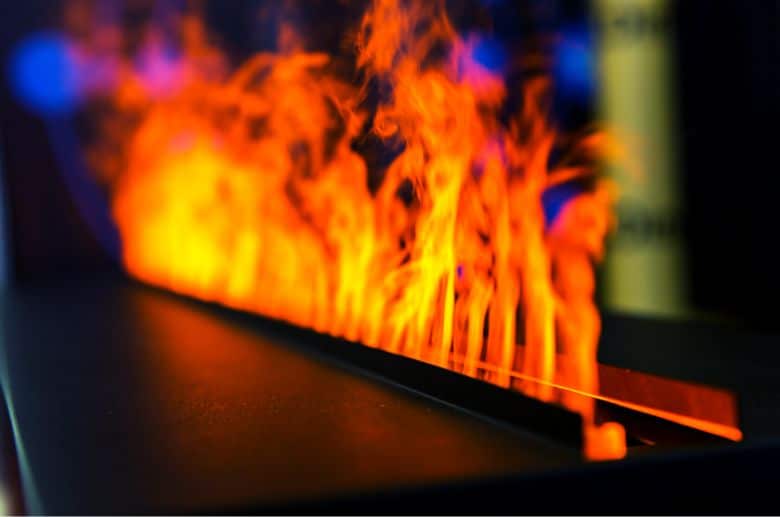
As modern gas fireplaces gain popularity, their features are also expanding.
Flame adjustment, for example, enables homeowners to modify the fireplace’s flame using a remote control, allowing them to regulate the room’s temperature effortlessly from the comfort of their seats.
3. Gas Fireplace Control Types
Gas fireplaces can be operated through different types of controls. Here’s a brief description of the most widely used options to help you choose the best one according to your needs:
Switch
Your gas fireplace can be switched on/off through a switch. It’s a simple option and as easy as turning a light on/off.
Thermostat
A thermostat is one of the best options for a gas fireplace as it allows automation. Homeowners can set the desired temperature, and your fireplace will automatically start if the temperature falls below the set temperature and stop once the desired temperature is maintained.
Any type of thermostat can be used for a gas fireplace, but the most popular choice is a millivolt thermostat. Millivolt thermostats are easy to install because you don’t need to connect them to the house’s wiring. These thermostats work on low voltage and can be programmed according to your needs.
A nest thermostat (a type of millivolt thermostat) is another easy-to-use thermostat that homeowners can connect to their gas fireplace.
Remote Control
If you want to avoid the hassle of getting up and turning the gas fireplace on/off, you can use a remote control. You can either connect it directly to your fireplace or connect it to a switch or a thermostat and use the remote as an extension.
——
Do You Need to Hire Chimney & Fireplace Expert?
Get free quotes from qualified experts near you. No commitment required!
——
4. Ignition System
The ignition systems of gas fireplaces can be categorized into two main types: millivolt and electronic ignition. Both types have their benefits and limitations. Let’s discuss each of them so that you can decide which one best suits your needs.
Millivolt Ignition
A millivolt ignition system uses a standing pilot light that stays on. You’ll need to light the pilot light with a match or lighter at the start, after which it’ll stay on 24/7. After that, you can turn your fireplace on/off with the help of a switch or remote control. You can manually turn your fireplace on despite a power outage.
Millivolt ignition is the most popular ignition system in gas fireplaces and appliances. It’s easier to find technicians to fix these systems since most of them are familiar with them. Millivolt ignition is also safe since the fireplace will shut down automatically if something goes wrong.
The only issue with millivolt ignition is that the pilot light stays on 24/7, costing homeowners 600 – 800 BTUs of fuel every hour.
Electronic Ignition
Electronic ignition or Intermittent Pilot Ignition (IPI) does not use a pilot light. Instead, it relies on electric power to light the pilot with the flip of a switch or remote control. With electric ignition, IPI saves a lot on fuel costs.
In case of a power outage, a gas fireplace running on IPI will need a battery backup to start.
Since IPI is relatively new, not all technicians are familiar with it. It might be hard to find a technician that’ll be able to fix it lest something goes wrong.
Continuous Pilot Ignition
Newer gas fireplace models come with electronic ignition with both intermittent pilot ignition (IPI) and continuous pilot ignition (CPI.) These ignition systems offer the best of both worlds. While you can use the IPI mode in the summer to save fuel, you can convert to CPI in winter to take advantage of the standing pilot light.
5. Total Gas Fireplace BTUs
As a rough estimate, 65,000 BTUs will heat a 3,000 sq. ft. house. But numerous factors affect the heating capacity of a fireplace, and only an expert can factor in everything and recommend a gas fireplace with the required heating capacity.
Most homeowners only consider the area of their homes to ensure that their fireplace can heat it. But it’s also essential to consider the ceiling height since your home’s total volume needs to be considered.
Other things that affect the heating capacity of your fireplace include
- Windows (as cold air can get inside)
- Layout design (open/sectioned)
- Home insulation
- Gas fireplace type
- Other vented appliances
- Climate
A higher number of windows or poor insulation reduce a fireplace’s heating capacity. So such homes will require a fireplace that produces more BTUs to compensate for the heat lost.
6. Realistic Effect Fireplace LED Lights
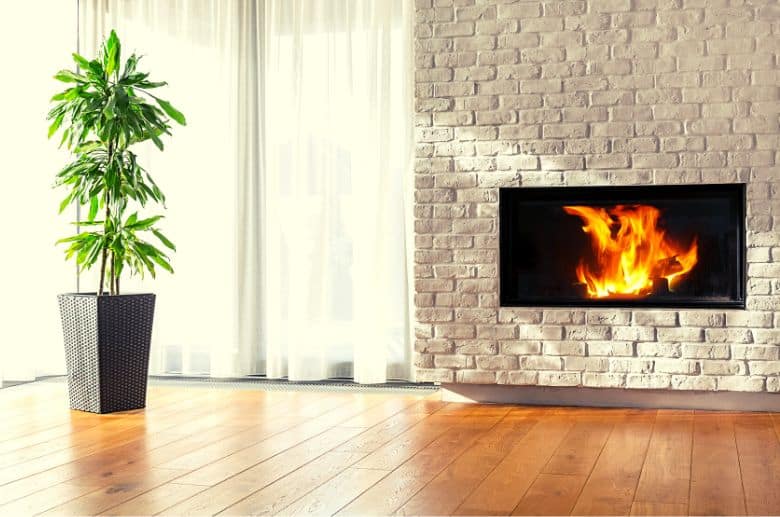
Gas fireplaces also come with LED lights that provide a traditional fireplace with an aesthetically pleasing and realistic look. Some modern fireplaces also have an optional multicolor LED kit. Homeowners can light their fireplace with any color in the spectrum using a remote that comes with the kit.
Homeowners can keep the lights on even if the fireplace is not in use.
7. Battery Backup Option
Older gas fireplaces didn’t require electricity, but the newer versions do. If you live in an area with frequent power outages, it’s best to get a gas fireplace that doesn’t require electricity. These fireplaces use a standing pilot light that helps ignite the fireplace instantly without electricity.
Since a standing pilot wastes a lot of fuel, homeowners prefer IPI gas fireplaces. Since IPI requires electricity for ignition, you can get a backup battery to help keep you warm even during power outages. Nowadays, many fireplace companies provide gas fireplaces with backup batteries.
The backup battery will help start your gas fireplace through IPI, but the blower won’t work. This means the heat radius will become much smaller, and your fireplace won’t heat the entire room.
8. Blower Fan
You might have heard gas fireplaces have blowers that spread the heat through convection. But not all gas fireplaces have blowers installed. Getting one with a blower is better because it provides better heat circulation and lowers energy bills. So when buying a gas fireplace, make sure you ask the seller whether the fireplace has a blower installed.
What if you’ve already purchased a gas fireplace, and it doesn’t have a blower? The good news is that you can install a blower in almost all gas fireplaces. But the installation cost will be higher (around $400 to $600) if you install it after the fireplace has already been installed.
9. Gas Fireplace Servicing and Maintenance
Gas fireplaces provide cleaner burn and don’t leave behind wood ash, smoke, or soot inside the chimney. Still, they need regular cleaning and maintenance to run efficiently for a longer period.
CO poisoning is another issue with gas fireplaces (especially ventless ones) that a thorough inspection and servicing can resolve. Before every burning season, check your gas fireplace and its venting for any leaks or damage. Also, get CO detectors in your rooms for additional safety.
While you can do a DIY cleaning of your gas fireplace, hiring a certified chimney sweep is best. That’s because you’re working with natural gas piping which can be dangerous.
During gas fireplace maintenance, you need to:
- Check the fireplace exterior to ensure it is secure and has no cracks or gaps.
- Clean the fireplace glass and check for any loose or cracked glass.
- Ensure that the gasket seals of the fireplace glass are airtight. If not, add caulking.
- Inspect gas ignition to see if it’s working properly.
- Check for signs of gas leaks.
- Vacuum out dust, pet hair, and other debris from the fireplace interior.
- Inspect and clean the chimney.
- Check for signs of condensation on the chimney exterior and interior walls near the chimney.
If your fireplace runs frequently throughout the winter season, you’ll need to get it inspected and cleaned at least once yearly. But if your gas fireplace runs only occasionally, servicing your fireplace once every two years is enough.
——
Do You Need to Hire Chimney & Fireplace Expert?
Get free quotes from qualified experts near you. No commitment required!
——
Types of Gas Fireplaces
Now that you’ve got an understanding of the various features available in a gas fireplace, it’s time to discuss the different gas fireplace types. Each type has its benefits and limitations; knowing about them will allow you to decide the best gas fireplace type for your home.
Let’s dive in.
Gas fireplaces come in different styles depending upon their use and available options for installation. Below is a brief explanation of the available gas fireplace styles:
Free-Standing Gas Fireplace
Free-standing gas fireplaces are among the most popular choices for homeowners. That’s because they provide a cost-effective and hassle-free heating solution. What’s more, these units are super easy to install. All you need is some free space to install vertical venting, ideally beside a wall.
Built-In Gas Fireplaces
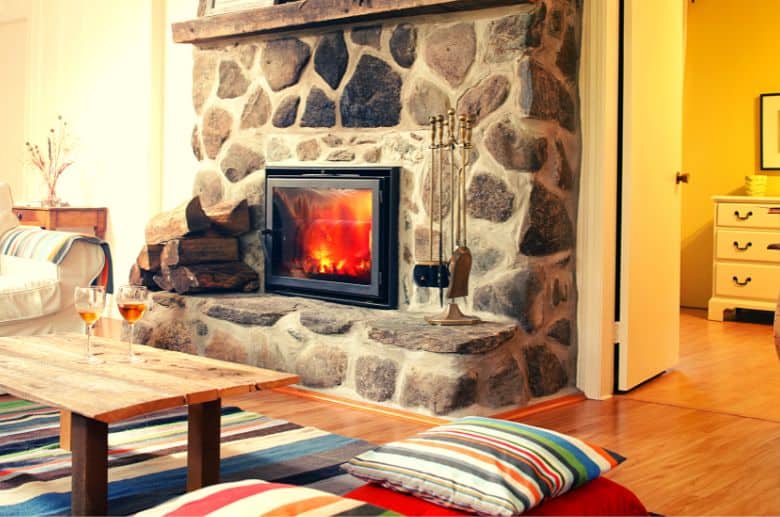
Built-in gas fireplaces are great if you want to add both warmth and style to your room. These fireplaces provide a considerable amount of heat and provide a modern feel to your room.
These fireplaces are wall-mounted and need some construction work during installation. It’s best to install a built-in gas fireplace in larger rooms as they need a lot of space.
Built-in gas fireplaces come in a variety of sleek and unique designs. So it’s almost certain that you’ll find one that complements your room.
Gas Fireplace Inserts
Gas fireplace inserts provide a cost-effective option for homeowners that don’t want to go through the hassle of kindling a fire and cleaning out the ash.
A gas insert is a metallic box containing a burner surrounded by a larger metallic box that sits inside an existing wood-burning fireplace. The gas fireplace vents through the chimney of the wood-burning fireplace.
Gas fireplace inserts come with glass fronts for homeowners to view the flames and provide an aesthetically pleasing view. The glass front also provides a seal that keeps cold air from getting inside, which makes gas inserts more efficient. Gas inserts don’t produce as much heat as built-in gas fireplaces.
Gas Log Sets
You can use gas log sets if you’ve got a wood-burning fireplace that hasn’t been used in a while (with no plan of using it in the future.) Gas logs are made of ceramic and come with a gas burner. They come in both vented and ventless options.
Vented gas logs vent up through the chimney. On the other hand, ventless logs don’t need any vent inside your home. That is why experts don’t recommend running ventless gas logs for more than 2 hours at a time.
While gas logs are cheaper, they don’t provide as much heat as gas inserts or free-standing gas fireplaces. Most of the heat produced escapes through the chimney. That’s why homeowners usually buy gas log sets to create a visually pleasing environment.
Types of Gas Fireplace Venting
Gas fireplaces don’t need a chimney, but they do need to vent out exhaust gasses so that they don’t enter your home and cause health issues.
Below is a description of the different venting configurations available for different gas appliances for homeowners to choose the one that best suits their needs.
Direct Vent Gas Fireplace
Direct venting fireplaces can be vented vertically through the roof or horizontally through a wall. These fireplaces are easier to install and airtight. They don’t allow cold, outdoor air to enter your home or warm room air to get outside.
Two pipes are present in direct vent fireplaces. One is used to pull in air for combustion, while the other exhausts combustion’s byproducts outside.
Natural Draft Venting
A b-vent is installed in natural draft fireplaces. The hot air produced as a result of heating creates a natural upward draft that vents out the exhaust air. A draft hood is present to prevent variations in the outside pressure from affecting the burner.
This type of vent is installed through the home interior and up to the roof, which is why its installation is costly.
Another issue with natural draft venting is that some of the heat can escape through the vent.
Ventless or Vent-Free Gas Fireplace
As the name suggests, vent-free gas fireplaces do not need any ventilation or chimney for exhaust. Since the burner is 99% efficient, little to no combustion by-products are produced.
Vent-free fireplaces can be placed anywhere, unlike other gas fireplaces that cannot be placed in certain locations because of venting restrictions. They’re also cheaper to install because the need to install ventilation is eliminated.
Although vent-free fireplaces are the cleanest and most efficient, they still produce some combustion fumes. These fumes can cause irritation or trigger allergies in kids, elder individuals, or sensitive individuals.
Power Vent Gas Fireplace
If you want to install your gas fireplace in a place where it’s not possible to install conventional vents, you can get a power vent gas fireplace. In such units, venting occurs with the help of an electrical fan using either vertical or horizontal vents.
Gas Fireplace Opening Types
Gas fireplaces can also be categorized based on their openings. The different opening types
Open-Front Gas Fireplace
An open-front gas fireplace works in the same manner as a conventional wood-burning fireplace. Both use air from the inside to provide oxygen for combustion. The only difference is that gas fireplaces use much cleaner fuel and are easier to operate.
Open-front gas fireplaces are popular because of their aesthetics. But since the fireplace is open, some of the warmth produced will be lost through the vent. That is why open-front gas fireplaces are not as efficient as glass-sealed gas fireplaces.
Glass-Sealed Gas Fireplace

Glass-sealed gas fireplaces provide 85-90% efficiency since no heat is lost through the fireplace. Combustion air is pulled into the chamber from outside.
Room air is passed through the heat exchanger, making it warm. This warm air is then sent back into the room with the help of a fan or through a system of ducts.
Since the fireplace is sealed, there is no danger of harmful fumes getting into your room, making it a much safer option.
Gas Fireplace Designs
Gas fireplaces have come a long way since they first started to appear in American homes and markets. While they started simple, they have now incorporated state-of-the-art technology and come in innumerable designs.
With so much to choose from, it can get hard for homeowners to find the perfect match. Here we have presented some of the most popular gas fireplace designs so that you can choose the best fit for your home.
Contemporary Gas Fireplace

Contemporary gas fireplaces offer both functionality and aesthetics. Inspired by European design, modern gas fireplaces usually come with linear flames, colored glass, and innumerable designs.
Homeowners looking for a more modern look can choose contemporary gas fireplaces. Regarding positioning, you can place your gas fireplace with tv above or position it at eye level to make it the center of attention.
Traditional Gas Fireplace
Some people prefer the feel of traditional wood-burning fireplaces. At the same time, they want the ease and utility of a remote-controlled gas fireplace. Such people can choose traditional gas fireplaces that look so real that it can be hard to notice the difference.
Transitional Gas Fireplace
If you can’t seem to decide between a modern or traditional look, go for transitional gas fireplaces. Offering the functionality of modern fireplaces, the transitional design allows homeowners to customize their fireplaces with either a traditional or a modern look.
Transitional gas fireplaces mix the classic look of a traditional fireplace with a more balanced, modern design.
See-Through Fireplace
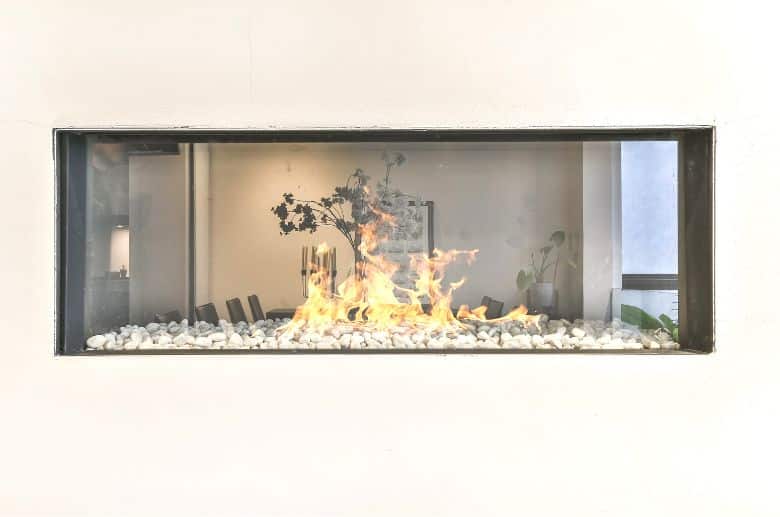
See-through fireplaces are best suited for open-plan homes. You can use these fireplaces as a divider while also allowing a glimpse of the other side. See-through fireplaces can also be used as indoor/outdoor fireplaces, creating aesthetically pleasing decor.
Linear Gas Fireplace
Linear gas fireplaces are among the most popular modern gas fireplace designs. These fireplaces create a classic impact wall, increasing the beauty of the room. Linear fireplaces come in various models that homeowners can choose according to their liking.
Peninsula Gas Fireplace
A peninsula gas fireplace has three sides and looks incredible in a large space. It can also be used to connect and provide heat to three rooms without needing to add extra fireplaces.
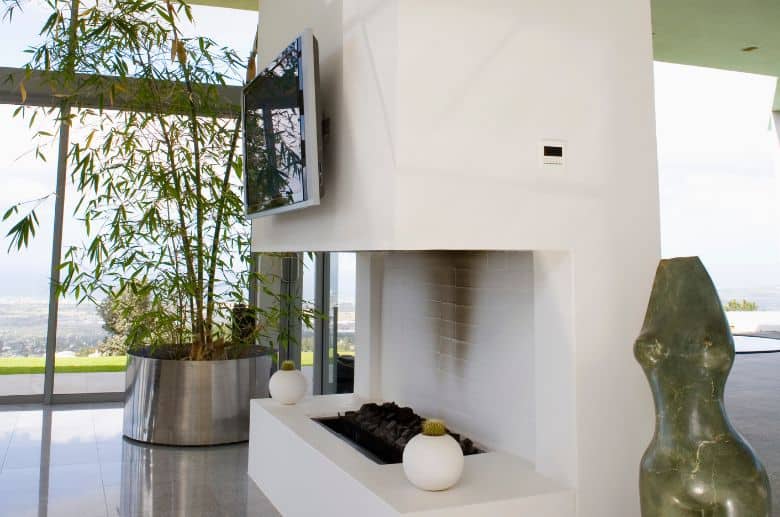
Corner Gas Fireplace
You can get a corner gas fireplace if you don’t want your fireplace to gain much attention or if you’re a bit short on space. These fireplaces sit in the corner of your room, providing heat and increasing the charm of your room.
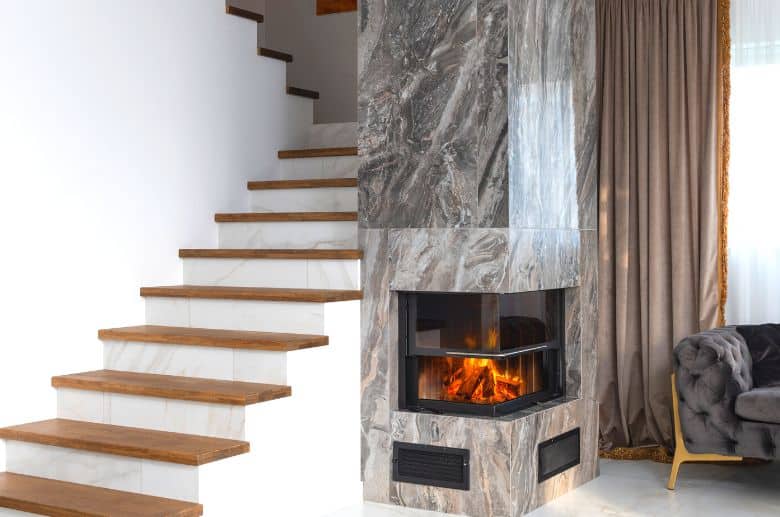
Gas Fireplace Building Code Requirements
Gas fireplaces, like other fireplaces, come with certain building code requirements that homeowners need to follow. These codes ensure the proper functioning of the fireplace and the safety of the owners.
Here are some of the key gas fireplace building code requirements:
- The fireplace opening needs to be surrounded by a heat-resistant material.
- No combustible material should be within 6 inches of the fireplace opening.
- Gas fireplaces (vented or unvented) should not be installed in confined rooms.
- If the gas fireplace is installed in a sleeping room, there should be an oxygen depletion safety shutoff system. Also, the input rating should be below 10,000 Btu/hr.
- Gas fireplace installation should follow the manufacturer’s instructions.
While these are the general gas fireplace installation requirements, the exact requirements may differ depending on the gas fireplace type, manufacturer’s instructions, and local building codes. Since the requirements may vary, it’s best to hire a certified chimney expert for the installation to ensure the installation codes are followed.
Gas Fireplace Cost
Gas fireplace types come in a variety of sizes, designs, and operational parameters. These factors impact the final price of the fireplace, which is why it is hard to offer an exact figure. Nevertheless, here’s a table of the estimated gas fireplace cost of different types of gas fireplaces.
| Fireplace Type | Estimated Cost (Low) | Estimated Cost (High) |
| Built-In Gas Fireplace | $1,000 | $2,500 |
| Gas Fireplace Insert | $3,000 | $4,500 |
| Wall Mount Gas Fireplace | $800 | $3,000 |
| Outdoor Gas Fireplace | $3,000 | $10,000 |
| Ventless Gas Fireplace | $1,000 | $3,500 |
Installation Cost
Apart from the unit cost, there is an additional cost of installation. Again the cost of installation varies based on the fireplace type. For example, installing a built-in gas fireplace and its heart costs around $4,000. But if you install a gas fireplace insert into an existing wood-burning fireplace, the cost will be around $1000. Moreover, ventless gas fireplace installation costs around $2,000 to $3,000, while installing a direct vent gas fireplace can cost up to $10,000.
The Takeaway
For good reasons, people are shifting away from their traditional wood-burning fireplaces. Modern gas fireplaces are easier to operate, produce less toxic gasses or other by-products of combustion, and offer functionality that homeowners couldn’t have even imagined just a few years ago.
However, before rushing toward retail stores, it’s best to equip yourself with all the different gas fireplace types, models, features, and designs offered in gas fireplaces.






